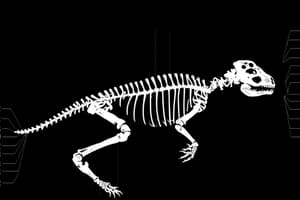Podcast
Questions and Answers
What is systematics? How is it used to develop phylogenetic trees?
What is systematics? How is it used to develop phylogenetic trees?
Systematics is a discipline focused on classifying organisms and determining their evolutionary relationships. Phylogenetic trees display the systematics.
What is phylogeny?
What is phylogeny?
The evolutionary history of a species.
What is taxonomy?
What is taxonomy?
How organisms are named and classified.
What is your binomial? What does it mean?
What is your binomial? What does it mean?
What are the two components of every binomial?
What are the two components of every binomial?
What are the orders of taxonomy (hierarchical categories)?
What are the orders of taxonomy (hierarchical categories)?
What is a taxon?
What is a taxon?
Which are more closely related, organisms in the same phylum or those in the same order?
Which are more closely related, organisms in the same phylum or those in the same order?
Label the common ancestor (each branch point) of the striped and otters, and then label the common ancestor of cats and dogs.
Label the common ancestor (each branch point) of the striped and otters, and then label the common ancestor of cats and dogs.
What is a phylogenetic tree?
What is a phylogenetic tree?
What are sister taxa?
What are sister taxa?
What is a basal taxon?
What is a basal taxon?
What is an outgroup?
What is an outgroup?
What is molecular systematics? How is it a valuable tool to sort homology from analogy?
What is molecular systematics? How is it a valuable tool to sort homology from analogy?
What is a clade?
What is a clade?
What does it mean to be monophyletic?
What does it mean to be monophyletic?
What does it mean to be paraphyletic?
What does it mean to be paraphyletic?
What does it mean to be polyphyletic?
What does it mean to be polyphyletic?
What are shared derived characters?
What are shared derived characters?
Explain why for mammals, hair is a shared derived character, but a backbone is not.
Explain why for mammals, hair is a shared derived character, but a backbone is not.
What is maximum likelihood?
What is maximum likelihood?
What is maximum parsimony?
What is maximum parsimony?
DNA that codes for what changes relatively slowly over years?
DNA that codes for what changes relatively slowly over years?
DNA that codes for what evolves rapidly?
DNA that codes for what evolves rapidly?
Which method (rRNA or mtDNA) reveals that fungi are more closely related to animals than to green plants?
Which method (rRNA or mtDNA) reveals that fungi are more closely related to animals than to green plants?
Which method (rRNA or mtDNA) reveals that the Pima of Arizona and Yanomami of Venezuela are descendants of the same Native American species?
Which method (rRNA or mtDNA) reveals that the Pima of Arizona and Yanomami of Venezuela are descendants of the same Native American species?
What are the two homologous genes?
What are the two homologous genes?
What are orthologous genes?
What are orthologous genes?
What are paralogous genes?
What are paralogous genes?
What are molecular clocks?
What are molecular clocks?
If a molecular clock is used, approximately when did HIV emerge?
If a molecular clock is used, approximately when did HIV emerge?
What are the three domains?
What are the three domains?
What two domains include all prokaryotes?
What two domains include all prokaryotes?
Which two domains are most closely related?
Which two domains are most closely related?
Which kingdom is made obsolete by the three-domain system? Why?
Which kingdom is made obsolete by the three-domain system? Why?
Which kingdom crumbled because it is polyphyletic?
Which kingdom crumbled because it is polyphyletic?
What is horizontal gene transfer?
What is horizontal gene transfer?
Flashcards are hidden until you start studying
Study Notes
Systematics and Phylogeny
- Systematics classifies organisms and determines their evolutionary relationships.
- Phylogenetic trees visually represent these relationships and evolutionary history.
- Phylogeny refers to the evolutionary history of a species, essential for understanding organism relationships.
Taxonomy
- Taxonomy is the method of naming and classifying organisms.
- A binomial consists of two parts: the genus (capitalized) and the species (specific epithet in Latin).
- Taxonomic hierarchy includes species, genus, family, order, class, phylum, kingdom, and domain.
Phylogenetic Trees
- A phylogenetic tree displays evolutionary history, illustrating patterns of descent among organisms.
- Sister taxa are groups that share the same immediate common ancestor.
- A basal taxon diverges early in a lineage, making it distinct from other members.
Clades and Taxa
- A clade includes an ancestral species and all its descendants, showing monophyly.
- Monophyletic groups include all descendants, while paraphyletic groups include some, and polyphyletic groups include unrelated species without a recent common ancestor.
- Shared derived characters are traits that originated in an ancestor of a particular taxon.
Molecular Systematics
- Molecular systematics uses genetic data to identify homologies (similar DNA sequences) versus analogies (similar traits due to convergent evolution).
- rRNA evolves slowly and helps analyze ancient taxa, while mtDNA evolves quickly, useful for recent evolutionary events.
Evolutionary Analysis
- Maximum likelihood and maximum parsimony are methods for evaluating phylogenetic hypotheses based on DNA sequences and the simplest explanations, respectively.
- Molecular clocks estimate evolutionary timelines, with some genes evolving at constant rates.
Domains of Life
- There are three domains: Bacteria, Archaea, and Eukarya.
- Bacteria and Archaea encompass all prokaryotes, while Eukarya is closely related to Archaea.
- The kingdom Monera becomes obsolete as it mixes organisms from different domains, and the kingdom Protista is considered polyphyletic due to its diverse members.
Horizontal Gene Transfer
- Horizontal gene transfer refers to genetic exchange between organisms, complicating phylogenetic analysis and resulting in inconsistent relationships in trees derived from different genes.
Studying That Suits You
Use AI to generate personalized quizzes and flashcards to suit your learning preferences.




